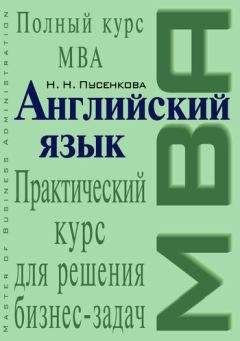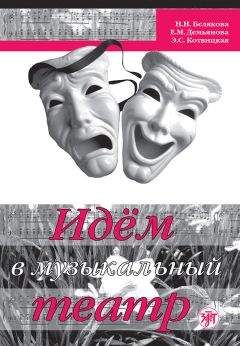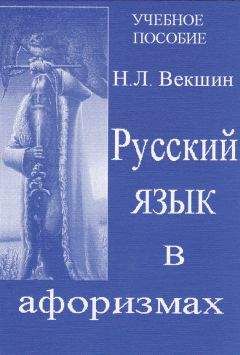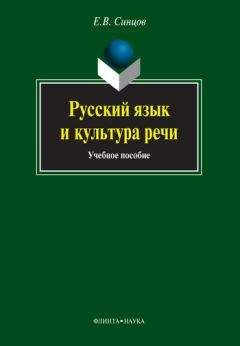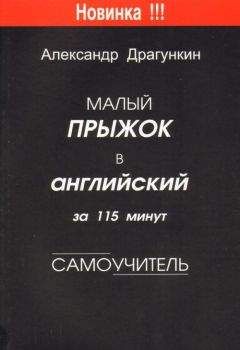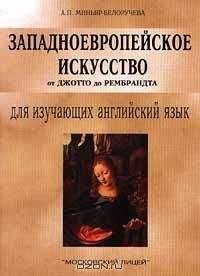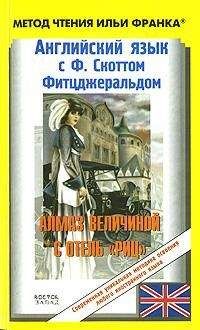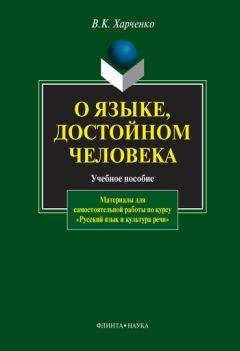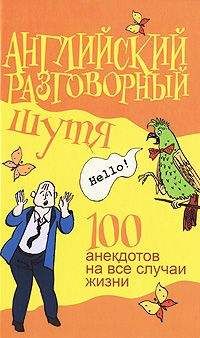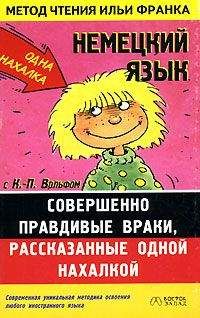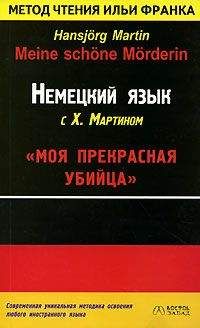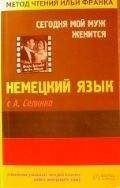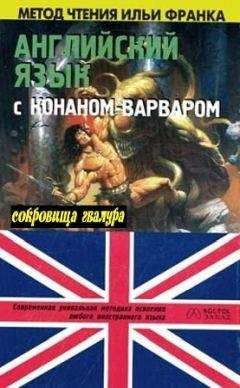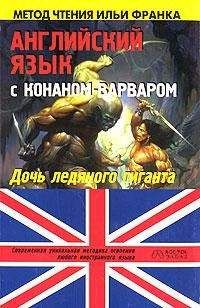Алла Миньяр-Белоручева - Западноевропейское искусство от Хогарта до Сальвадора Дали
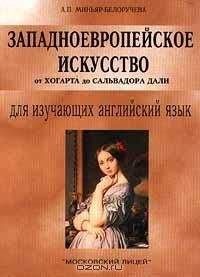
Скачивание начинается... Если скачивание не началось автоматически, пожалуйста нажмите на эту ссылку.
Жалоба
Напишите нам, и мы в срочном порядке примем меры.
Описание книги "Западноевропейское искусство от Хогарта до Сальвадора Дали"
Описание и краткое содержание "Западноевропейское искусство от Хогарта до Сальвадора Дали" читать бесплатно онлайн.
Тексты настоящего пособия охватывают почти три века истории западноевропейского искусства от Хогарта до Сальвадора Дали. Это позволяет обучаемым наряду с усвоением обширного лексического материала, приобрести культурологические знания, поскольку тексты содержат информацию о жизни и творчестве крупнейших западно-европейских художников XVIII – XX вв. Система упражнений направлена на усвоение лексического материала и развитие навыков устной речи.
Данная книга является второй частью цикла учебных пособий «Западноевропейское искусство (для изучающих английский язык)». В первую книгу вошли тексты, охватывающие пять веков западноевропейской живописи oт Джотто до Рембрандта. Данное пособие предназначено для студентов-искусствоведов, учащихся классических гимназий, лицеистов и всех изучающих английский язык и интересующихся западноевропейским искусством.
In the Bark of Dante, of 1822, Delacroix illustrates a moment from the Divine Comedy in which the poet, accompanied by Virgil, is steered across the dark tides of the lake surrounding the city of Dis, attacked in the sulphurous dimness by damned souls rising from the waves against a background of towers and flames. In this painting Delacroix has broken up the pyramidal grouping, and is more concerned with effects of colour and of light and dark than with form. Some of the drops of water are painted in pure tones of red and green. Delacroix's basic compositional principle is a series of free curves, arising from the central area and always returning to it. This painting was highly praised.
Delacroix's next major work the Massacre at Chios, of 1824, was not easily accepted. The subject was an incident from the Greek wars of liberation against the Turks, which had excited the sympathies of Romantic spirit everywhere. The foreground is scattered with bodies. The neobaroque composition is diffused in Delacroix's centrifugal curves, which part to display the distant slaughter and conflagration. The observer's sympathies are supposed to be with the sufferings of the Greeks, but their rendering is not convincing. The expressions tend to become standardised; the head of the young woman at the lower left almost repeats that of the dead mother at the lower right. This picture was called the «massacre of painting.» The colour shows a richness and vibrancy not visible in French painting since the Rococo. He brought this huge picture to Paris for the Salon of 1824, and before the exhibition opened he took it down and repainted it in tones emulating those, he found in Constable. From here on, Delacroix's interest in colour was great. He investigated colour contrasts on the canvas and in nature and derived a law – «the more contrast the greater the force.»
With the Death of Sardanapalus as a manifesto of Romanticism, the artist drew down upon himself the disapproval of royal administrators. The legendary subject concerns the last of the Assyrian monarchs, besieged in his palace for two years by the Medes. On hearing that the enemy had at last breached his walls, the king had all his concubines, slaves, and horses slaughtered and his treasures destroyed before his eyes, as he lay upon a couch soon to become his funeral pyre. Lacking the pretext of humanitarianism that justified the Massacre at Chios and other pictures inspired by the Greek struggle for independence, the painting becomes a feast of violence, spread out in glowing colours against the smoke of distant battle. The picture is a phantasmagoria in which no real cruelty is exerted. Faces are paralysed with fear but no blood flows. Quivering female flesh is heaped like flowers or fruit, among the glittering jewels and the fabrics of crimson. In his solitary fantasy the artist, identifying himself in imagination with the king and the executioners, discharges all his creative and destructive energy in an explosion of tones.
The Revolution of 1830, which placed on the throne Louis Philippe, the «Citizen King» brought Delacroix relief from poverty. In 1832 he travelled through North Africa with the French delegation. He was the first major painter of modern times to visit the Islamic world. And this was the only real adventure of his life. Although he had no opportunity to paint, and found even drawing dangerous on account of Islamic hostility to representation, he brought back with him hundreds of sketches in pencil or pen. His memory of exotic sights and colours, his vivid imagination provided him with endless material for paintings for the next thirty years.
Delacroix's memories of North Africa were realised in the Women of Algiers, a picture of exquisite intimacy and charm, painted and exhibited in 1834. This picture had an enormous influence on the Impressionists of the late nineteenth century and on many paintings of the early twentieth century, especially Matisse.
Most of the pictures of North African subjects painted during Delacroix's later years were less tranquil. The Tiger Hunt, of 1854, is typical, with forms and poses born of the artist's imagination. In 1847 Delacroix wrote, «When the colours are right, the lines draw themselves," and so they do, in the movements of the raging animals and furious huntsmen, flowing out from the centre and back again with passionate intensity and perfect logic. Almost weightless, liberated from matter, these late fantasies of violence carry the artist into a phase of free colouristic movement pointing directly toward the twentieth century.
Make sure you know how to pronounce the following words:
Eugen Delacroix; Mozart; Dante; Romanticism; Venetian; Virgil; massacre; Chios; Medes; Sardanapalus; Assyrian; Matisse; Islamic; Beethoven; Algiers
NotesBark of Dante – «Ладья Данте»
Divine Comedy – " Божественная комедия»
Massacre at Chios – «Хиосская резня»
Death of Sardanapalus – «Смерть Сарданапала»
Women of Algiers – «Алжирские женщины в своих покоях»
Tiger Hunt – «Охота на тигров»
Dis – Дит (у Данте имя Люцифера и название области нижнего Ада)
«Citizen King» – король-буржуа
TasksI. Read the text. Make sure you understand it. Mark the following statements true or false.
1. Delacroix produced thousands of oil paintings.
2. Delacroix's idol in music was Chopin.
3. Delacroix painted scenes full of harmony.
4. Delacroix was loyal to Raphael and Rembrandt.
5. Colour was the major determinant in Delacroix's works.
6. Delacroix identified himself with the Assyrian monarch.
II. How well have you read? Can you answer the following questions?
1. What artistic movement did Delacroix embody? What did Delacroix write about illusions and reality?
2. What did Delacroix write about his projects?
3. What moment did Delacroix show in the Bark of Dante? What compositional principle did he use in this painting? How was this picture treated by the public?
4. What is the subject of the Massacre at Chios? How was this picture called? What did Delacroix do with the picture when it was brought to the Salon?
5. What painting became a manifesto of Romanticism? What is the subject of this work of art?
6. What was the only real adventure of Delacroix's life? What is realised in the Women of Algiers? What did Delacroix write about painting in 1854?
III. i. Give Russian equivalents of the following phrases:
to create the illusions; free colouristic movement; to produce water-colours; scenes of violence; to derive the subjects from poetry and from medieval history; sulphurous dimness; to break up the pyramidal grouping; Romantic spirit; centrifugal curves; to display the distant slaughter and conflagration; the richness of colour; a feast of violence; sketches in pencil; to derive a law.
ii. Give English equivalents of the following phrases:
свободное движение цвета; карандашные наброски; изобразить резню и пожар вдали; дух романтизма; вывести закон; богатство красок; сцены насилия; создать иллюзии; разрушить пирамидальную группу; черпать сюжеты из поэзии и средневековой истории; создавать акварели; основной композиционный принцип; центростремительные линии; разрушительная энергия.
iii. Make up sentences of your own with the given phrases.
iv. Arrange the following in the pairs of synonyms:
a) solitary; emotional; to admire; derive; conflagration
b) lonely; obtain; to praise; fire; passionate.
IV. Here are descriptions of some of Delacroix's works of art. Match them up to the titles given below.
1. This picture is a phantasmagoria with no real cruelty.
2. Delacroix illustrates a moment in which the poet is steered across the dark tides of the lake.
3. These fantasies point directly toward the twentieth century.
4. The subject was an incident from the Greek wars of libe-ration against the Turks.
5. This picture had a great influence on the Impressionists.
a) Massacre at Chios
b) Tiger Hunt
c) Women of Algiers
d) Bark of Dante
e) Death of Sardanapalus
V. Translate the text into English.
Выставленная в Салоне в 1824 г. картина «Резня в Хиосе» сделала Делакруа вождем романтизма. Картина получила неоднозначную оценку. Одни ею восхищались, другие называли картину резней живописи. Делакруа не признавал данное ему звание романтика. Романтизм противопоставлялся классицизму и имел расплывчатое определение. Однако, несмотря на отсутствие программы, стал мощным художественным движением XIX в.
В Салоне в 1827 г. Делакруа выставил большое полотно «Смерть Сарданапала», которое стало манифестом романтизма. Картину оценили должным образом только в 1921 г., когда она была куплена Лувром.
Эжен Делакруа жил интенсивной духовной жизнью. Его кумирами были: в живописи – Гойя и Рубенс, в музыке – Моцарт. Первая работа Делакруа «Ладья Данте», вдохновленная «Божественной комедией» Данте, подверглась сильной критике.
Поездки Делакруа в конце 1831 – 1832 г. в мусульманские страны вдохновили художника на создание прекрасных картин, одной из которых является «Алжирские женщины в своих покоях» 1834).
VI. Summarize the text.
VII. Topics for discussion.
1. Romanticism in art.
2. Delacroix's style and characters.
3. Delacroix's artistic heritage.
Unit VII Constable (1776-1837)
The mainstream of English painting in the first half of the nineteenth century was landscape. Constable and Turner, the greatest of the landscapists, approached nature with excitement. At that time nature was beginning to be swallowed up by the expanding cities of the Industrial Revolution.
John Constable, the son of a miller on the River Stour in Suffolk, honoured all that was natural and traditional, including the age-old occupation of farmer, miller, and carpenter, close to the land whose fruits and forces they turned to human use. He loved the poetic landscapes of Gainsborough, he studied the constructed compositions of the Baroque, he admired Ruisdael's skies. Rebelling against the brown tonality then fashionable in landscape painting – actually the result of discoloured varnish darkening the Old Masters – he supplemented his observations of nature with a study of the vivacity of Rubens's colour and brushwork.
As early as 1802, Constable started to record the fleeing aspects of the sky in the rapid oil sketches made outdoors. «It will be difficult to name a class of landscape in which sky is not the keynote, the standard of scale, and the chief organ of sentiment," he wrote. Constable systematically studied cloud formation in 1821-22. These studies show his surrender to the forces of nature, a passionate self-identification with sunlight, wind, and moisture.
Constable never left England and made dutiful sketching tours through regions of acknowledged scenic beauty. His superb The Hay Wain, of 1821, sums up his ideals and his achievements. Composed as if accidentally – though on the basis of many preliminary outdoor studies – the picture, painted in the studio, shows Constable's beloved Stour with its trees, a mill, and distant fields. In his orchestra of natural colour the solo instrument and conductor at once is the sky. The clouds sweep by, full of light and colour, and their shadows and the sunlight spot the field with green and gold. As the stream ripples, it mirrors now the trees, now the sky. The trees are made up of many shades of green and patches of light reflect from their foliage. These white highlights were called «Constable's snow». The Hay Wain was triumphantly exhibited at the Salon of 1824, where Constable's broken colour and free brushwork set in motion a new current in French landscape art, which later culminated in the Impressionist movement.
In 1829 Constable became member of the Royal Academy.
In later life, after the death of his wife, Constable entered a period of depression in which his passionate communion with nature reached a pitch of semi-mystical intensity. One of his late pictures is Stroke-by-Nayland, of 1836-37, a large canvas in which the distant church tower, the wagon, the plough, the horses, and the boy looking over the gate are instruments on which light plays. The symphonic breadth, of the picture, and its crushing chords of colour painted in a rapid technique, bring to the finished painting the immediacy of the colour sketch. Such pictures are equalled in earlier art only by certain landscape backgrounds in Titian or by the mythical reveries of the late Rembrandt.
Make sure you know how to pronounce the following words:
Constable; Turner; Ruisdael Stour; Suffolk; chords; triumphantly; varnish; palette; plough; wain; flexible; culminated; plank
NotesThe Hay Wain – «Телега для сена»
Suffolk – Суффолк (графство)
Stour – р. Ст(а)ур
TasksI. Read the text. Make sure you understand it. Mark the following statements true or false.
1. Constable was the greatest English portraitist.
2. In the first half of the eighteenth century nature was beginning to be swallowed up by the expanding cities of the Industrial Revolution.
3. Discoloured varnish darkened the Old Masters.
4. Constable often visited Italy, Belgium, Holland and Spain.
5. The Hay Wain was highly praised at the Salon of 1834.
6. In 1829 Constable became member of the Royal Academy.
Подписывайтесь на наши страницы в социальных сетях.
Будьте в курсе последних книжных новинок, комментируйте, обсуждайте. Мы ждём Вас!
Похожие книги на "Западноевропейское искусство от Хогарта до Сальвадора Дали"
Книги похожие на "Западноевропейское искусство от Хогарта до Сальвадора Дали" читать онлайн или скачать бесплатно полные версии.
Мы рекомендуем Вам зарегистрироваться либо войти на сайт под своим именем.
Отзывы о "Алла Миньяр-Белоручева - Западноевропейское искусство от Хогарта до Сальвадора Дали"
Отзывы читателей о книге "Западноевропейское искусство от Хогарта до Сальвадора Дали", комментарии и мнения людей о произведении.





